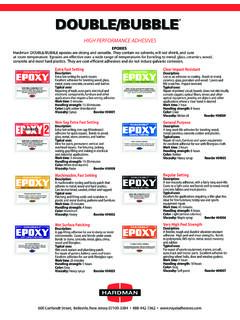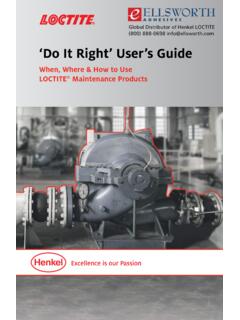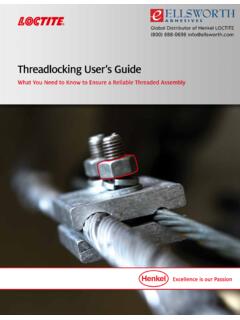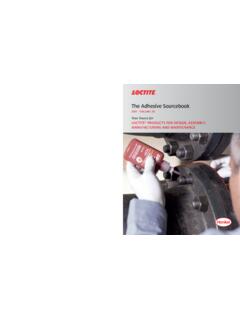Transcription of Loctite Design Guide for Bonding Plastic - Ellsworth Adhesives
1 Design Guide for Bonding PlasticsVolume 62011 Design Guide for Bonding PlasticsVolume 6LT-2197 Henkel CorporationEngineering CorporationEngineering AdhesivesOne Henkel WayRocky Hill, Connecticut 06067 Tel: ( )Tel: : Canada CorporationEngineering Adhesives2225 Meadowpine , Ontario L5N 7P2 Tel: (within Canada)Tel: : marks are trademarks and/or registered trademarks of their respective companies. = registered in the Patent and Trademark Office. Henkel Corporation, 2011. All rights reserved. 7078/LT-2197 (2/11)Global Distributor of Henkel Loctite (800) 888-0698 of ContentsThe Loctite Design Guide for Bonding Plastics.
2 Volume 6 Introduction 2 How To Use The Plastic BondingGuide Chapters 3 How To Use The adhesive Shear Strength Table 5 Description Of Adhesives 6 Cyanoacrylate Adhesives 6 Epoxy Adhesives 7 Hot Melt Adhesives 8 Light curing Acrylic Adhesives 9 Polyurethane Adhesives 10 Silicone Adhesives 11 No-Mix and Static Mix Acrylic Adhesives 12 Why Bond Plastics with Loctite Brand Adhesives 13 Plastic Properties And adhesive Performance 14 Acetal Homopolymer 14 Acrylic (PMMA) 16 Acrylic-Styrene-Acrylonitrile (ASA) 18 Acrylonitrile-Butadiene-Styrene (ABS) 20 Diallyl Phthalate (DAP, DAIP) 22 Cellulose Acetate Proprionate (CAP) 24 Epoxy 26 Fluoropolymers (PTFE, FEP, PFA, ETFE) 28 Ionomer 30 Liquid Crystal Polymer (LCP) 32 Phenolic 34 Polyamide (Nylon) 36 Polybutylene Terephthalate (PBT) 38 Polycarbonate (PC) 40 Polyester 42 Polyetheretherketone (PEEK) 44 Polyetherimide (PEI) 46 Polyethersulfone (PES) 48 Polyethylene (PE) 50 Polyethylene Terephthalate (PET) 52 Polyimide (PI) 54 Polymethylpentene (PMP) 56 Polyphenylene Oxide (PPO) 58 Polyphenylene Sulfide (PPS) 60 Polypropylene (PP)
3 62 Polystyrene (PS) 64 Polyurethane (PU) 66 Polyvinyl Chloride (PVC) 68 Styrene-Acrylonitrile (SAN) 70 Vinyl Ester 72 Stress Cracking Resistance Table 74 Surface Treatments 75 adhesive Abrading 75 Chromic Acid Etching 75 Corona Discharge 75 Flame Treatment 75 Iodine Treatment 75 Plasma Treatment 75 Primers 75 Sodium Treatment 76 Surface Grafting 76 Surface Roughening 76 Thermal Treatment 76 Transcrystalline Growth 76 UV Exposure 76 adhesive Joint Design 77 Types of Joints 77 Joint Stress Distribution 78 Types of Stresses 78 Design Guidelines 79 Processor Rules For Good adhesive Assembly 80 Test Methodology 84 Test Methods 86 Did You Know?
4 88 Glossary 90 Index of Trade Names 91 Acknowledgements 95 Disclaimer 96 The ProblemThe Loctite Design Guide for Bonding Plastics, Volume 62 Plastics have become an integral part of everyday life. It would be difficult to identify a manufacturing process which does not use plastics in one form or another. Even products which appear to be composed exclusively of metals are usually coated, sealed, or adhesively joined using polymeric materials which improve the performance, appearance, and longevity of the metal have achieved widespread acceptance due to the virtually limitless combinations of Plastic types, fillers, and additives which can be compounded at relatively low costs and processed by a wide variety of methods.
5 This gives Plastic producers the ability to tailor their products to the specific needs of manufacturers with great precision. By properly selecting the Plastic types, additives, and filler, as well as blends of different Plastic types, the physical, chemical, and thermal properties of a Plastic can be made to meet or exceed the performance requirements of almost any , while the limitless variety of plastics is an invaluable asset to a designer selecting a Plastic , it is the designer s biggest limitation when selecting an adhesive . The countless Adhesives available, coupled with the virtually limitless grades of plastics available, make it highly unlikely that there will be any specific bond strength data for the adhesive / Plastic combination in the designer s application.
6 Moreover, every year new grades of Plastic are created, and old grades of Plastic are discontinued or reformulated, making the acquisition of comprehensive bond strength data on specific grades virtually SolutionBond Strength InformationThis Guide is designed to indicate the bondability of the 30 most commonly used Plastic types, without performing the impossible task of actually testing each individual grade. For the first two volumes of this Guide , this was accomplished using two basic approaches. For the first approach, 17 of the 30 plastics which were evaluated were compounded specifically to determine the effect different additives and fillers had on the bondability of these plastics.
7 Once the designer identifies the tested formulations containing the same filler and additives as the particular grade in his Design , he can then pinpoint the Adhesives which performed the best on that material and will have a general idea of what bond strengths can be achieved. For the other 13 plastics, commercially available grades were selected to represent each major category available based on the major end-use applications of that Plastic , the filler and additives typically used with that Plastic , and/or the chemical structure of that Plastic . Again, the bond strength information supplied can then be used as an indicator of the bondability of a three and four of this Guide are focused on increasing the number of Adhesives tested on one grade of commercially available plastics.
8 It can be inferred that the same strength trends seen in the original charts will hold true for the truncated tables found in this InformationAn adhesive cannot be selected for an application solely on the basis of bond strength information. Other factors such as the cure speed, environmental resistance, thermal resistance, and suitability for automation of an adhesive will play a critical role in determining the best adhesive for a specific application. To give a designer insight into these Design parameters, an in-depth description of the seven adhesive types, namely cyanoacrylates, no-mix/static mix acrylics, hot melts, epoxies, polyurethanes, silicones and light curing acrylics, has been included in this Guide .
9 These adhesive sections contain a general description of each adhesive , a detailed discussion of the chemical structure and cure mechanism of each adhesive , and the benefits and limitations of using each InformationA manufacturer may have the flexibility to select the material which is best suited for the application in terms of performance and bondability. To aid the designer, an in-depth discussion of each of the Plastic types is included. Information covered includes a general description of the Plastic and its properties, as well as a list of trade names, suppliers, typical applications, and pricing TreatmentsSome applications will require the use of plastics which are inherently difficult to bond.
10 In these cases, the use of a surface treatment is necessary to effectively utilize the adhesive . In earlier versions of this Guide , each individual material was evaluated using two of the more commonly used surface treatments, surface roughening and polyolefin primers. Again, due to the size of the updated adhesive matrix, no surface treatments were evaluated for the updated strength tables. The Design engineer can use the earlier data and make correlations to the newer chemistries to get an idea of how surface treatments will affect the bond. In addition, the 12 most commonly used surface treatments are briefly described in the Surface Treatments Design InformationFinally, a manufacturer may have a Design in which it is desired to incorporate an adhesively bonded joint.








